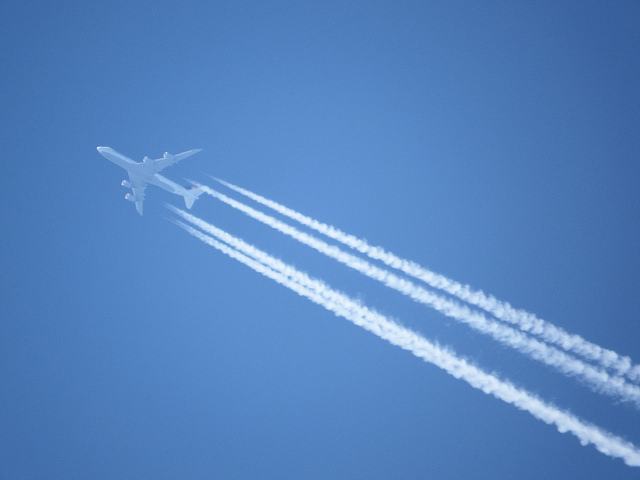CONtrails | Photo: fdecomite, CC BY 2.0
A survey published this week in the peer-reviewed journal Environmental Review Letters found that, when asked to explain typically-given “evidence” of SLAPs (Secret Large-scale Atmospheric Programs, aka “chemtrails”), experts in two key areas overwhelmingly found nothing there to support the claims.
The researchers identified and reached out to hundreds of scientists broken into two groups, on the one hand, “atmospheric scientists with expertise in condensation trails” and on the other, “geochemists working on atmospheric deposition of dust and pollution on the Earth’s surface” — the former because some of the oft-given “evidence” is in observations of the trails themselves, and the latter because some of said “evidence” consists of taking samples of snow and pond water and getting them tested for metals.
The responses roundly rejected the premise of chemtrails as the simplest explanation for any of the evidence given, and only one of the 77 respondents found anything suspicious at all (the odd one out found aluminum levels in a snow sample suspiciously high, which was explainable by the fact that the sample was not just snow, but “snow surface,” including the dust that naturally accumulates on top of it). They also roundly rejected the instructions given on chemtrail-conspiracy websites for collecting water and snow, largely agreeing that the instructions, if followed, would contaminate the samples and lead to much higher levels of metals and other contaminants.
There was also a significant proportion of experts who agreed that contrails were fewer and shorter-lived in the past, though they gave plenty of reasons this might be the case, ranging from planes flying at higher altitudes where contrails are more likely to form, to better (and more efficient) engines producing cooler exhaust that’s more likely to produce contrails, to climate change making the moisture content of the air higher and — you guessed it — making contrails more likely to form.
So the long and short of it is, if you ask experts, they don’t see the existence of “chemtrails” as likely, they don’t see evidence for the existence of “chemtrails,” and they think the way you’re collecting your evidence to support your “chemtrail” conspiracy theory is going to lead you to erroneously conclude that there is evidence to support your preconceived notions.
You can read the paper for yourself at: “Quantifying expert consensus against the existence of a secret, large-scale atmospheric spraying program.”
Happy Monday, everyone.
***
That’s all for today. Thanks for reading! I only get paid in my own (and your) enthusiasm, so please like This Week In Tomorrow on Facebook, follow me on Twitter @TWITomorrow, and tell your friends about the site!
If you like our posts and want to support our site, please share it with others, on Facebook, Twitter, Reddit — anywhere you think people might want to read what we’ve written. Thanks so much for reading, and have a great week.
***
Richard Ford Burley is a human, writer, and doctoral candidate at Boston College, as well as an editor at Ledger, the first academic journal devoted to Bitcoin and other cryptocurrencies. In his spare time he writes about science, skepticism, feminism, and futurism here at This Week In Tomorrow.

